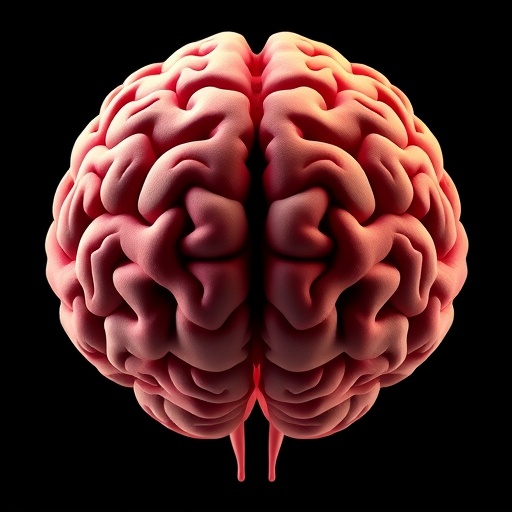In recent years, the intricate development of the human brain has captivated neuroscientists seeking to unravel the mysteries of cognitive and psychiatric outcomes across the lifespan. A groundbreaking study published in Nature Communications illuminates a critical piece of this puzzle: the role of brain asymmetry during development and its profound influence on adolescent mental health and cognition. This work, led by Wu, Zhang, Kuang, and collaborators, provides an unprecedented exploration of how subtle structural and functional imbalances between the brain’s two hemispheres guide the neurobiological trajectories that underpin adolescent behavior and mental wellness.
The human brain, famously asymmetric in both anatomy and function, displays lateralization patterns that are fundamental to language, spatial skills, emotional processing, and many other cognitive domains. While these asymmetries are well characterized in adulthood, this study ventures deep into the developmental period, shedding light on their origin and longitudinal impact. Using advanced neuroimaging modalities paired with comprehensive psychological assessments, the researchers tracked a cohort of adolescents, examining how the evolving architecture of hemispheric differences correlated with cognitive performance metrics and psychiatric symptomatology.
One of the landmark findings emerges from the nuanced observation that asymmetry is not a static trait but a dynamic property shaped during critical windows of brain maturation. The team employed longitudinal MRI scans, focusing on cortical thickness, surface area, and white matter integrity to chart asymmetric growth patterns. These neuroanatomical markers were then analyzed in relation to behavioral assessments encompassing executive function, memory, emotional regulation, and risk for mood and anxiety disorders. The results suggest that individuals exhibiting atypical or delayed emergence of typical brain asymmetry profiles tended to score lower on cognitive tests and reported higher psychiatric symptoms.
Delving further into the mechanistic underpinnings, the study discusses how interhemispheric connectivity and microstructural properties of the corpus callosum—the vital nerve fiber tract connecting the two hemispheres—mediate these developmental asymmetries. The authors suggest that disruptions in the timing or extent of callosal maturation can hinder efficient cross-talk between hemispheres, leading to aberrant functional specialization. Such dysregulation potentially manifests as impaired cognitive control or emotional instability during the vulnerable adolescent years.
Intriguingly, the research also highlights sex differences in brain asymmetry trajectories. Female participants tended to show earlier and more pronounced lateralization in regions implicated in language and social cognition, while males demonstrated a more protracted development with distinct asymmetry patterns in motor and visuospatial circuits. These findings echo prior literature on sexual dimorphism in brain development but bring forth novel associations with mental health outcomes, suggesting that sex-specific neurodevelopmental pathways must be considered in understanding adolescent psychiatric disorders.
The use of cutting-edge computational neuroimaging techniques allowed the team to move beyond gross anatomical measures to finer-scale interpretations such as cortical folding patterns, gyrification indices, and regional myelin content. These parameters enriched the characterization of brain asymmetry and revealed that even subtle morphological deviations could forecast differences in cognitive trajectories. For instance, aberrant gyrification in the right prefrontal cortex correlated with deficits in inhibitory control, a crucial executive function frequently compromised in adolescent-onset disorders like ADHD.
Importantly, the study situates its findings within an integrative biopsychosocial framework. Brain asymmetry patterns did not exist in isolation but were modulated by environmental factors such as socioeconomic status, early-life stress, and educational quality. The authors posited that adverse environments might exacerbate atypical asymmetry development, highlighting potential intervention points. This complex interplay underscores the necessity for multi-dimensional approaches when assessing risk and resilience factors in adolescent mental health.
From a psychiatric perspective, the study breaks new ground by linking specific lateralization patterns to symptom clusters in depression, anxiety, and psychosis-spectrum conditions. It appears that altered asymmetry in limbic and prefrontal circuits may underpin emotional dysregulation and maladaptive processing seen in these disorders. Such biomarkers offer exciting prospects for early detection and personalized therapeutic strategies, tailoring interventions based on individual brain developmental profiles.
The longitudinal design of the study adds robustness and clinical relevance, capturing how early deviations in brain asymmetry presage cognitive impairments and psychiatric symptoms emerging during teenage years. This temporal dimension affords insights into potential critical periods for intervention and the plasticity of these neural systems. The authors advocate for follow-up studies to determine whether therapeutic modulation of brain asymmetry trajectories could ameliorate or prevent the progression of mental health disorders.
Methodologically, the integration of multimodal neuroimaging data with extensive neuropsychological batteries and sophisticated statistical modeling sets a new standard for developmental neuroscience research. The application of machine learning approaches to classify participants based on asymmetry profiles further accentuates the translational potential of the findings, paving the way for predictive analytics in clinical settings.
Beyond the immediate scientific contributions, this research carries broader implications for understanding the biological roots of individuality in cognition and behavior. It encapsulates how the brain’s asymmetric development serves as a fundamental scaffold upon which diverse mental faculties and vulnerabilities are built, reflecting a delicate balance shaped by genetics, neurobiology, and environment.
In light of these discoveries, future research directions may seek to decode the molecular genetic drivers of asymmetrical brain growth and their interaction with epigenetic mechanisms. Furthermore, expanding the investigation to include diverse populations with varied cultural and environmental backgrounds will be pivotal to generalize these findings globally.
In conclusion, the pioneering work by Wu and colleagues underscores the vital importance of brain asymmetry as a determinant of adolescent cognitive and psychiatric health. By elucidating the developmental pathways that sculpt hemispheric specialization, their study not only advances fundamental neuroscience but also heralds new avenues for early diagnostics and individualized interventions in youth mental health.
Subject of Research: Developing brain asymmetry and its impact on cognitive and psychiatric outcomes during adolescence.
Article Title: Developing brain asymmetry shapes cognitive and psychiatric outcomes in adolescence
Article References: Wu, X., Zhang, K., Kuang, N. et al. Developing brain asymmetry shapes cognitive and psychiatric outcomes in adolescence. Nat Commun 16, 4480 (2025). https://doi.org/10.1038/s41467-025-59110-9
Image Credits: AI Generated




